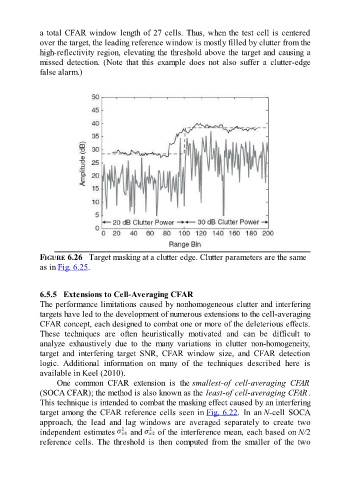Page 516 - Fundamentals of Radar Signal Processing
P. 516
a total CFAR window length of 27 cells. Thus, when the test cell is centered
over the target, the leading reference window is mostly filled by clutter from the
high-reflectivity region, elevating the threshold above the target and causing a
missed detection. (Note that this example does not also suffer a clutter-edge
false alarm.)
FIGURE 6.26 Target masking at a clutter edge. Clutter parameters are the same
as in Fig. 6.25.
6.5.5 Extensions to Cell-Averaging CFAR
The performance limitations caused by nonhomogeneous clutter and interfering
targets have led to the development of numerous extensions to the cell-averaging
CFAR concept, each designed to combat one or more of the deleterious effects.
These techniques are often heuristically motivated and can be difficult to
analyze exhaustively due to the many variations in clutter non-homogeneity,
target and interfering target SNR, CFAR window size, and CFAR detection
logic. Additional information on many of the techniques described here is
available in Keel (2010).
One common CFAR extension is the smallest-of cell-averaging CFAR
(SOCA CFAR); the method is also known as the least-of cell-averaging CFAR.
This technique is intended to combat the masking effect caused by an interfering
target among the CFAR reference cells seen in Fig. 6.22. In an N-cell SOCA
approach, the lead and lag windows are averaged separately to create two
independent estimates and of the interference mean, each based on N/2
reference cells. The threshold is then computed from the smaller of the two

